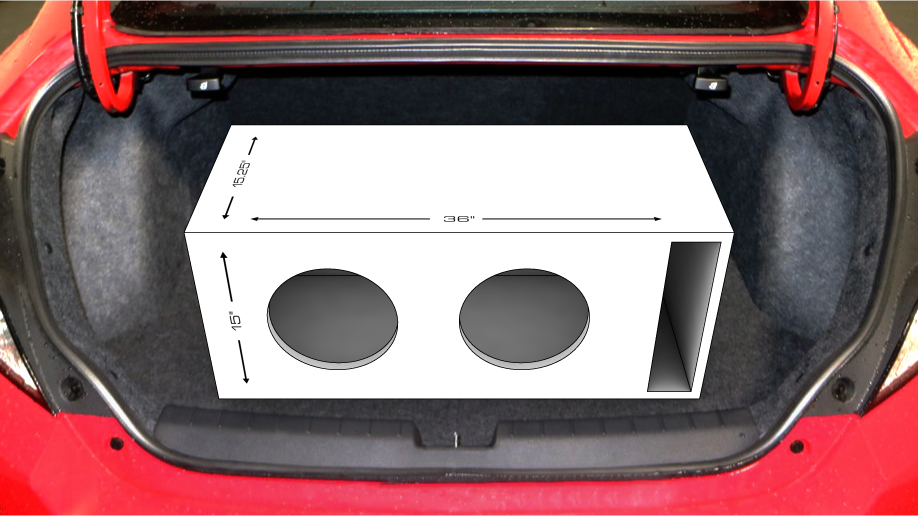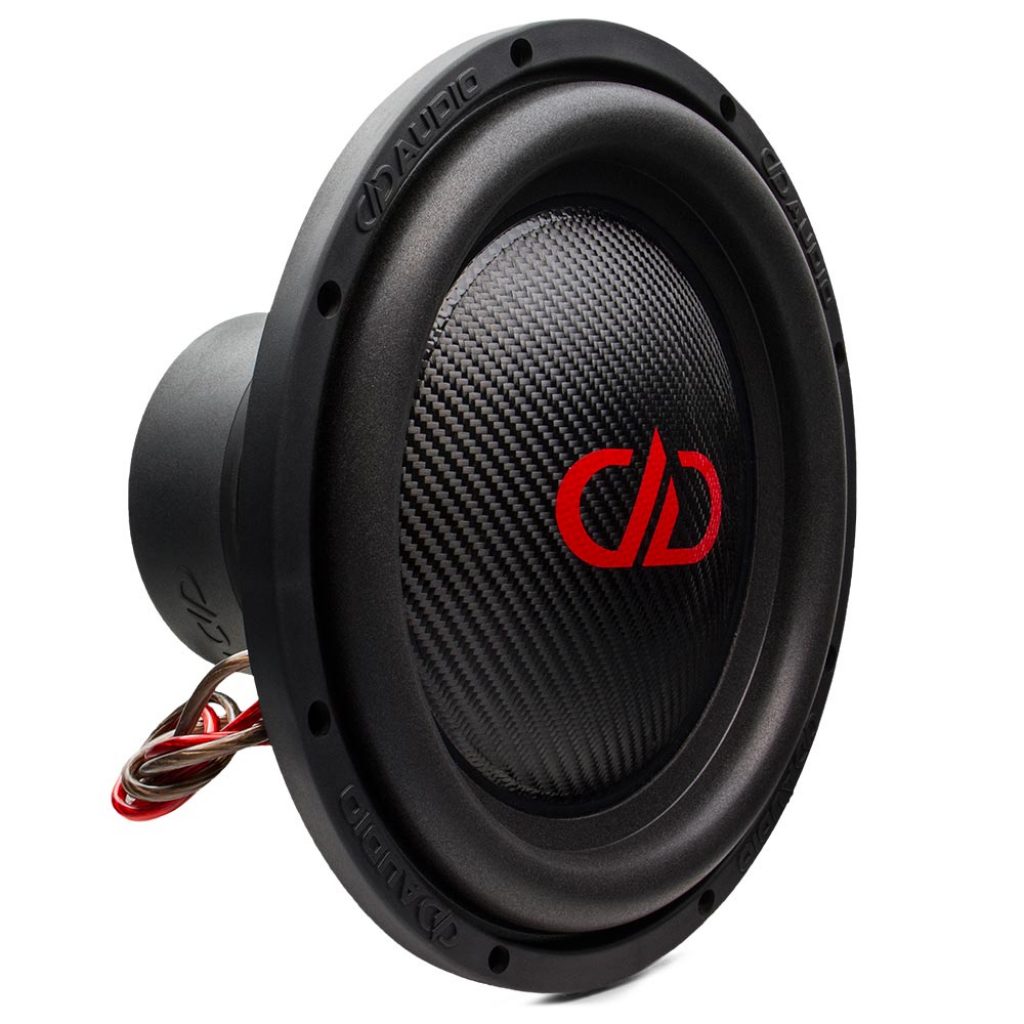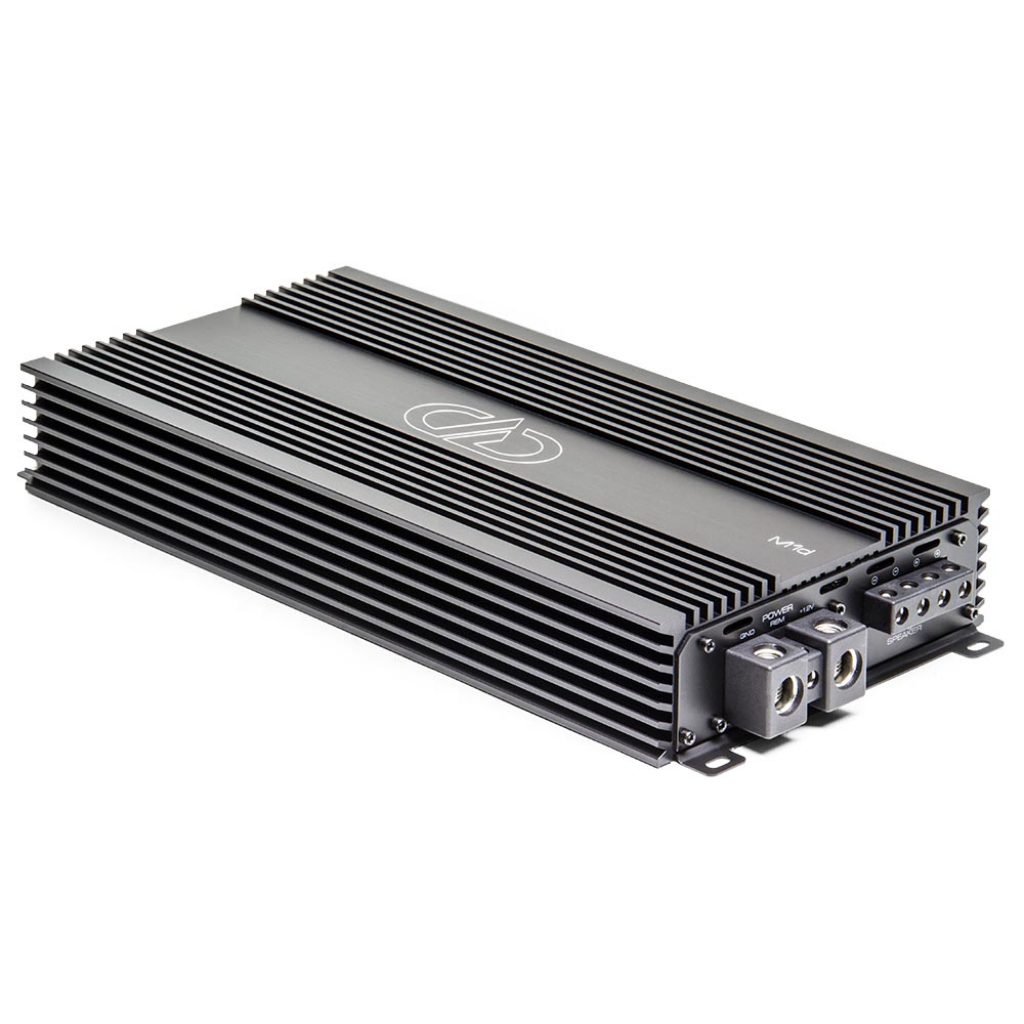
Tech Talk: Speedy Enclosure Designs – How to Design a Subwoofer Enclosure that Doesn’t Suck in 10 Minutes or Less
Is it perfect? No, but will it get the job done? Absolutely! There’s a magical world between the pre-fabricated salt and pepper enclosures stacked up at your local car stereo store and the hyper accurate modeled enclosure that’s fiberglassed, molded and wrapped in leather with LED back lit plexiglass. Making subwoofer specific enclosures is an area where a lot of shops excel. Many shops will incorporate the vehicle into the design as well, but we’re going to make it very easy today. Today we’re going to look at how to design an enclosure for your DD woofer in less than 10 minutes.
The first thing we need to do is decide how much bass you want. Ideally this will be a reasonable size for your vehicle… don’t go trying to shove four 15” subs into your Civic Coupe and expect it to go over well with this method. However, let’s say that we do have a Civic Coupe and we’re going to put 2 10’s in it so we have enough space to still fit groceries. We’ve chosen 2 1500 Series Power Tuned 10 Inch Subwoofers for my build and we’re going to power them with an M1d M Series Monoblock Amplifiers. It’s a great package that should jam in this Civic.
Once we know what the system looks like and we know it’s reasonable for the space we have (if you’re not sure what’s reasonable, check out This Sweet Article on how to find out how much bass will fit in your space), we need to get an idea of how big this enclosure needs to be. Behold, the DD Box System in all its glory.
BOX SIZES FOR HIGH EFFICIENCY SUBWOOFER SYSTEMS
^ft = cubic feet | sq” = square inch
All volumes listed are after vent, and subwoofer displacement; a.k.a. NET volume
This chart is for tuning boxes in the 35-40Hz range.
| Volume | Number & Size of Drivers | Port Area & Length |
| 0.35^ft | (1) 6.5″ | 5.25 sq” vent x 24.5″ long |
| 0.50^ft | (1-2) 6.5″ | 7.0 sq” vent x 24″ long |
| 0.75^ft | (2) 6.5″ or (1) 8″ | 11.25 sq” vent x 23.5″ long |
| 1.00^ft | (2-3) 6.5″ or (1) 8″ | 15.0 sq” vent x 23″ long |
| 1.25^ft | (3-4) 6.5″ or (1) 8″ or (1) 10″ | 20.0 sq” vent x 29″ long |
| 1.50^ft | (3-4) 6.5″ or (2) 8″ or (1) 10″ | 24.0 sq” vent x 28.5″ long |
| 1.75^ft | (4) 6.5″ or (2) 8″ or (1) 12″ | 28.0 sq” vent x 28″ long |
| 2.00^ft | (4) 6.5″ or (2) 8″ or (1) 12″ | 32.0 sq” vent x 27.5″ long |
| 2.25^ft | (2-3) 8″ or (1) 12″ | 36.0 sq” vent x 27″ long |
| 2.50^ft | (3) 8″ or (2) 10″ or (1) 12″ | 40.0 sq” vent x 26.5″ long |
| 2.75^ft | (3) 8″ or (2) 10″ or (1) 12″ | 44.0 sq” vent x 26.5″ long |
| 3.00^ft | (3-4) 8″ or (2) 10″ or (1) 15″ | 48.0 sq” vent x 26″ long |
| 3.25^ft | (3-4) 8″ or (1) 15″ | 52.0 sq” vent x 25.5″ long |
| 3.50^ft | (3-4) 8″ or (2) 12″ or (1) 15″ | 56.0 sq” vent x 25.5″ long |
| 3.75^ft | (3-4) 8″ or (3) 10″ or (2) 12″ or (1) 15″ | 60.0 sq” vent x 25″ long |
| 4.00^ft | (4) 8″ or (3) 10″ or (2) 12″ or (1) 15″ | 64.0 sq” vent x 24.5″ long |
| 4.25^ft | (4) 8″ or (3) 10″ or (2) 12″ or (1) 15″ | 68.0 sq” vent x 24.5″ long |
| 4.50^ft | (4) 8″ or (3) 10″ or (2) 12″ or (1) 15″ | 72.0 sq” vent x 24″ long |
| 4.75^ft | (4) 8″ or (2) 12″ or (1) 15″ | 76.0 sq” vent x 23.5″ long |
| 5.00^ft | (4) 8″ or 10″ or (2) 12″ or (1) 15″ or 18″ | 80.0 sq” vent x 23.5″ long |
| 5.25^ft | (4) 10″ or (2-3) 12″ or (1) 18″ | 84.0 sq” vent x 23″ long |
| 5.50^ft | (4) 10″ or (2-3) 12″ or (1) 18″ | 88.0 sq” vent x 23″ long |
| 5.75^ft | (4) 10″ or (3) 12″ or (1) 18″ | 92.0 sq” vent x 22.5″ long |
| 6.00^ft | (4) 10″ or (3) 12″ or (2) 15″ or (1) 18″ | 96.0 sq” vent x 22″ long |
| …… | …… | …… |
| 8.00^ft | (3-4) 12″ or (2) 15″ or (1) 21″ | 128.0 sq” vent x 20″ long |
This chart will tell us exactly how much airspace we need for our system. Under (2) 10” we have the options for 2.5-3 cubic feet of net volume needed for this enclosure. We’re going to select the middle value of 2.75 cubic feet. Now, this is net volume so we need to calculate the gross volume to see exactly how big this enclosure will actually be. There are 2 main things, apart from bracing which is optional in this enclosure, that will occupy airspace in the enclosure – the woofers and the port. The airspace occupation of the woofers is easy enough to calculate because we’ve already done all the work for you. On the DD Audio Website you can find all Woofer Displacement values on each woofer’s respective page. Here’s the page for the 1500 Series woofers we’ll be using – Woofer Specs. Each woofer occupies 0.06 cubic feet or 0.12 cubic feet for the pair.

It’s all been pretty easy so far, right? It’s just a little careful navigation of the DD Audio website. Well here’s where that super difficult middle school math is going to come into play. In our magical Civic we’ve determined that we can build the enclosure 15” high and still be able to pull the enclosure in and out of the vehicle if need be. Since we’re going to be using ¾” MDF for our enclosure construction we can subtract the top and bottom sheets of the enclosure from our total height to find the internal height of the enclosure. We’ll need this number for the final calculation but it’s also going to help us with our port. Referencing the 2.75 cubic foot enclosure on the DD Box System chart, we’re going to need 44 square inches of port for this box. So we simply need to divide our port size by the 13.5” internal height of the enclosure, which is 3.25”. To figure out how much space our port occupies, we’ll add a ¾” piece of MDF to our port width to accommodate the dividing wall and multiply this number by the height of the port and the length of the port from the chart.
(3.25 x 0.75) x 13.5 x 26.5” = 1431 cubic inches or 0.83 cubic feet.
Now that we know our net volume goal, our woofer displacement and the space occupied by the port we can simply add the 3 values together to find out how big our enclosure actually needs to be.
2.75 + 0.12 + 0.83 = 3.7 cubic feet gross
This is the number we’ll need to calculate our outer enclosure dimensions. This is where everything comes together. We know that our enclosure is going to be 15” tall, and after measuring between the wheel wells in our Civic we’ve determined that we can build an enclosure that is 36” wide. This internal dimensions of these measurements are 13.5 and 34.5, respectively. So all we have to do is convert out 3.7 cubic feet to cubic inches (multiply by 1728) and divide it by our two known dimensions. The resulting number will be our previously unknown depth.
3.7 x 1728 = 6393.6 cubic inches
6393.6 / 13.5 / 34.5 = 13.72 inches
We can round up to 13.75” to keep our measurements easy. Just remember, this is the internal measurement, we’ll need to add 1.5” to this number to get the external dimension. So, the final external dimensions for this enclosure will be,
15” Tall x 36” Wide x 15.25” Deep

From here, you’re only 7-8 pieces of wood away from having a completed enclosure, depending on where you choose to stick the port. However, all the hard work of figuring out the math is taken care of. A basic enclosure, when you have the right tools at your disposal, can be a simple endeavor.
Check out the new DXBT-05 Wireless ANC Headphones!

